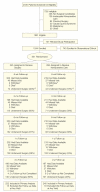Surgical vs nonoperative treatment for lumbar disk herniation: the Spine Patient Outcomes Research Trial (SPORT): a randomized trial
- PMID: 17119140
- PMCID: PMC2553805
- DOI: 10.1001/jama.296.20.2441
Surgical vs nonoperative treatment for lumbar disk herniation: the Spine Patient Outcomes Research Trial (SPORT): a randomized trial
Abstract
Context: Lumbar diskectomy is the most common surgical procedure performed for back and leg symptoms in US patients, but the efficacy of the procedure relative to nonoperative care remains controversial.
Objective: To assess the efficacy of surgery for lumbar intervertebral disk herniation.
Design, setting, and patients: The Spine Patient Outcomes Research Trial, a randomized clinical trial enrolling patients between March 2000 and November 2004 from 13 multidisciplinary spine clinics in 11 US states. Patients were 501 surgical candidates (mean age, 42 years; 42% women) with imaging-confirmed lumbar intervertebral disk herniation and persistent signs and symptoms of radiculopathy for at least 6 weeks.
Interventions: Standard open diskectomy vs nonoperative treatment individualized to the patient.
Main outcome measures: Primary outcomes were changes from baseline for the Medical Outcomes Study 36-item Short-Form Health Survey bodily pain and physical function scales and the modified Oswestry Disability Index (American Academy of Orthopaedic Surgeons MODEMS version) at 6 weeks, 3 months, 6 months, and 1 and 2 years from enrollment. Secondary outcomes included sciatica severity as measured by the Sciatica Bothersomeness Index, satisfaction with symptoms, self-reported improvement, and employment status.
Results: Adherence to assigned treatment was limited: 50% of patients assigned to surgery received surgery within 3 months of enrollment, while 30% of those assigned to nonoperative treatment received surgery in the same period. Intent-to-treat analyses demonstrated substantial improvements for all primary and secondary outcomes in both treatment groups. Between-group differences in improvements were consistently in favor of surgery for all periods but were small and not statistically significant for the primary outcomes.
Conclusions: Patients in both the surgery and the nonoperative treatment groups improved substantially over a 2-year period. Because of the large numbers of patients who crossed over in both directions, conclusions about the superiority or equivalence of the treatments are not warranted based on the intent-to-treat analysis.
Trial registration: clinicaltrials.gov Identifier: NCT00000410.
Figures



Comment in
-
Interpreting surgical trials with subjective outcomes: avoiding UnSPORTsmanlike conduct.JAMA. 2006 Nov 22;296(20):2483-5. doi: 10.1001/jama.296.20.2483. JAMA. 2006. PMID: 17119146 No abstract available.
-
Surgical treatment of lumbar disk disorders.JAMA. 2006 Nov 22;296(20):2485-7. doi: 10.1001/jama.296.20.2485. JAMA. 2006. PMID: 17119147 No abstract available.
-
Sham surgery in clinical trials.JAMA. 2007 Apr 11;297(14):1545-6; author reply 1546. doi: 10.1001/jama.297.14.1545-c. JAMA. 2007. PMID: 17426268 No abstract available.
-
Lumbar disc herniation--to operate or not to operate?Nat Clin Pract Neurol. 2007 Jun;3(6):316-7. doi: 10.1038/ncpneuro0499. Epub 2007 Apr 24. Nat Clin Pract Neurol. 2007. PMID: 17457310 No abstract available.
-
Either surgery or nonoperative treatment led to improvement in intervertebral disc herniation.J Bone Joint Surg Am. 2007 May;89(5):1139. doi: 10.2106/JBJS.8905.ebo3. J Bone Joint Surg Am. 2007. PMID: 17473165 No abstract available.
-
Inference and validity in the SPORT herniated lumbar disc randomized clinical trial.Spine J. 2007 Jul-Aug;7(4):387-91. doi: 10.1016/j.spinee.2007.04.010. Epub 2007 May 21. Spine J. 2007. PMID: 17630135 No abstract available.
-
What patients know.Surg Neurol. 2008 Jul;70(1):5-7. doi: 10.1016/j.surneu.2008.04.007. Epub 2008 May 14. Surg Neurol. 2008. PMID: 18482753 No abstract available.
-
Journal club: Spine patient outcomes research trial: do outcomes vary across centers for surgery for lumbar disc herniation?Neurosurgery. 2013 Aug;73(2):369-71. doi: 10.1227/01.neu.0000430330.33140.a6. Neurosurgery. 2013. PMID: 23867261 No abstract available.
References
-
- Boden SD, Davis DO, Dina TS, Patronas NJ, Wiesel SW. Abnormal magnetic-resonance scans of the lumbar spine in asymptomatic subjects: a prospective investigation. J Bone Joint Surg Am. 1990;72:403–408. - PubMed
-
- Jensen MC, Brant-Zawadzki MN, Obuchowski N, Modic MT, Malkasian D, Ross JS. Magnetic resonance imaging of the lumbar spine in people without back pain. N Engl J Med. 1994;331:69–73. - PubMed
-
- Saal JA, Saal JS. Nonoperative treatment of herniated lumbar intervertebral disc with radiculopathy. Spine. 1989;14:431–437. - PubMed
-
- Weinstein JN, Dartmouth Atlas Working Group . Dartmouth Atlas of Musculoskeletal Health Care. American Hospital Association Press; Chicago, Ill: 2000. - PubMed
-
- Deyo RA, Weinstein JN. Low back pain. N Engl J Med. 2001;344:363–370. - PubMed
Publication types
MeSH terms
Substances
Associated data
Grants and funding
LinkOut - more resources
Full Text Sources
Other Literature Sources
Medical

